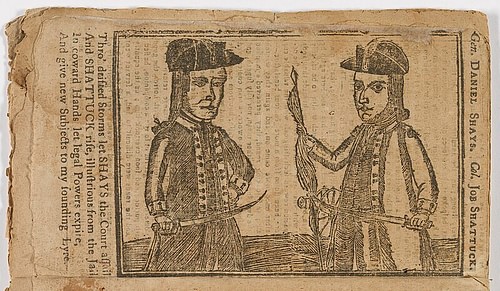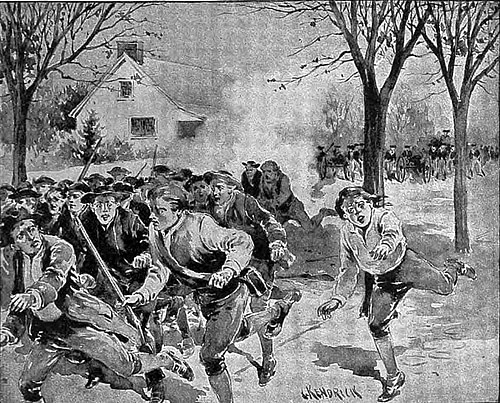
Shays' Rebellion (1786-87) was an armed insurrection by rural farmers in western and central Massachusetts, sparked by the state government's unpopular response to a debt crisis. The insurrection reached its climax when the rebels, referred to by some scholars as 'Shaysites', unsuccessfully assaulted a federal arsenal in Springfield, Massachusetts, ultimately leading to the rebellion's dissolution.
The rebellion erupted amidst an economic crisis and was largely the result of a feud between New England rural farmers and the coastal mercantile elite; when the farmers proved unable to pay debts owed to New English retailers and merchants, their creditors took harsh legal action, often resulting in the farmers losing their property or being thrown into debtors' jail. The farmers believed these judicial actions to be unjust and, in autumn 1786, surrounded courthouses in several Massachusetts towns to halt court proceedings. When the Massachusetts government responded by implementing a severe Riot Act and raising a private army, the protestors turned violent. Under the leadership of American Revolutionary War veteran Daniel Shays (the namesake of the rebellion) and others, the rebels surrounded Springfield Armory, with the intention of using the weapons within to launch an assault on Boston.
The Shaysites, however, were repulsed when they assaulted the armory on 25 January 1787. The rebels were then mopped up by the private army under General Benjamin Lincoln and the insurrection fizzled out shortly thereafter. Shays' Rebellion highlighted the inefficiency of the United States central government which, under the Articles of Confederation, had been powerless to send federal troops or otherwise intercede to stop the insurrection. The rebellion led many Americans to realize that a stronger central government was necessary, and it influenced the drafting and ratification of the US Constitution.
Debt Crisis
As noted by historian David P. Szatmary, the New England of the 18th century was a society in which aspects of 'rural tradition' and 'commercial expansion' coexisted and gradually came into conflict with one another (1). The vast majority of New Englanders existed within the former category as yeomen farmers or agricultural laborers, who lived in rural communities and often owned the land on which they worked. These farmers enjoyed a subsistence lifestyle, living off their own produce. Whenever they needed something from the market – shoes, for instance, or medicine – they would usually pay with surplus crops rather than in hard currency, which was scarce. If it had been a rough harvest season and the farmers did not have any surplus crops, retailers would often extend to them a line of credit, trusting the farmers to pay them back the next harvest season.
Simultaneously, a growing commercial economy was thriving in the coastal towns of Massachusetts and in the Connecticut River Valley, which relied on trade conducted by merchants. This mercantile class dominated politics in New England and was, therefore, a powerful interest group; indeed, it was partially the grievances of these merchants that had set the New England colonies on the path toward the American Revolution. These merchants had built their fortunes off trade with business contacts in Great Britain and the West Indies, exporting commodities such as timber and rum in exchange for various goods which would then be sold to the shopkeepers in New England's various market towns for resale. Like the yeomen farmers, the merchants did not have much hard currency on hand and were used to conducting business through lines of credit extended to them by their overseas business partners.
At the end of the American Revolutionary War in 1783, the New England merchants were eager to resume trade with their prewar business contacts in Britain and France. There was, however, a problem; the United States was experiencing a postwar economic depression and lacked a reliable national currency, making British merchants wary of extending new lines of credit to their New English counterparts. British merchants insisted that any future business dealings must be conducted entirely in hard currency and that all past debts must be immediately paid before commerce could resume. The New English merchants were taken aback by these demands but had no choice but to comply, since Britain was one of their only feasible overseas markets.
The merchants of New England did not have the hard currency that their overseas contacts were demanding; in 1786, for instance, Boston merchants collectively owed £80,000 in debt but had less than £25,000 in hard currency between them. To collect the coinage needed to reopen trade, the merchants decided to call in the debts owed to them by the storeowners of New England's rural market towns. But, of course, the storeowners were as cash-poor as the merchants and were forced to demand that their own customers, mostly yeomen farmers, pay up as well. The burden of the credit crisis, therefore, fell squarely on the shoulders of the farmers, who were at the bottom of this debt hierarchy and could not pass the buck downward. When the farmers tried to pay their debts with surplus crops, they were dismayed to learn that only hard currency would be accepted. This came at a time when the New England state governments were already levying high taxes to pay off their own war debts, imposing an extra financial strain on the rural population.
Growing Unrest
When the farmers proved unable to meet the harsh financial demands imposed on them by the mercantile class and government officials, their creditors resorted to legal action. Between 1784 and 1786, 2,977 debt cases were prosecuted by Hampshire County, Massachusetts, a 262% increase from the 1770-72 period. Worcester County, Massachusetts, saw 4,789 debt cases in the 1784-86 period, compared to only 1,200 between 1770 and 1772 (Szatmary, 29). Most of the defendants in these cases were poor rural farmers. By 1786, the practice had become so widespread that Governor Thomas Chittenden of Vermont observed, "lawsuits have become so numerous that there is hardly any money sufficient to pay for entering the actions, not to mention the debts" (Szatmary, 30).
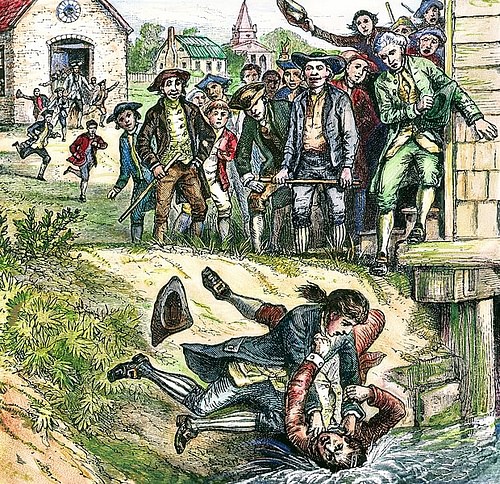
Farmers who lost these lawsuits were often liable to have their properties seized by county sheriffs and auctioned off. Since few potential buyers had much hard currency, the properties were usually sold at a fraction of their market value. These property seizures outraged and terrified the farmers, who feared that the loss of their lands would reduce them to the state of tenant farmers, beholden to landlords like feudal peasants. "To see a collector distrain upon one of their neighbors," wrote a contributor to the Independent Chronicle, "and carry off a hog, or his colt, for the payment of his taxes, this startles them exceedingly" (Szatmary, 33).
Those who still could not pay off their debts after having their property foreclosed faced the dreadful possibility of debtors' prison. At the time, New England jails were unsanitary and cramped, and inmates often went without adequate food; in Hampshire County, 73 people owing small amounts of debt were condemned to debtor's jail between 1784 and 1786, while Worcester County sentenced 145 during the same period for failure to pay their debts (Szatmary, 35).
Petitions & Protests
The prospect that rural farmers could be jailed and have their properties seized because they defaulted on debts that they could ill afford struck many New Englanders as contrary to the principles of the Revolution; after all, unjust taxes and fear of arbitrary imprisonment had been two of the leading factors that drove the United States to declare independence in the first place. In the mid-1780s, as the debt crisis unfolded, 73 towns from across Massachusetts sent petitions to Boston, asking for two pieces of protective legislation: the first was the establishment of state-issued paper money, which would depreciate the currency but would allow the farmers to pay their debts more easily. The second request was for tender laws, which would guarantee the right to pay for goods and services in kind as well as in cash.
Both proposals threatened the economic growth of the coastal merchants, who pressured the Massachusetts General Court to reject them; in November 1785, the General Court voted against both measures by wide margins but did not offer any alternative solutions to the farmers' financial strife. With no other options, many yeomen farmers began to arm themselves; George Brock, a farmer from Attleboro, Massachusetts, vented the frustrations of his peers, writing that the Massachusetts General Court was treating the yeomen as "traitors, incendiaries, vile creatures" who were being threatened with prosecution for "daring to inquire into the present gross mismanagement of our rulers" (Szatmary, 57). If the situation did not soon improve, Brock suggested that the yeomanry should revolt against "all the machinations of those who are aiming to enslave and oppress us" (ibid). Sensing the upheaval that was to come, Massachusetts Governor John Hancock resigned in early 1785, leaving his successor James Bowdoin to deal with the mess.
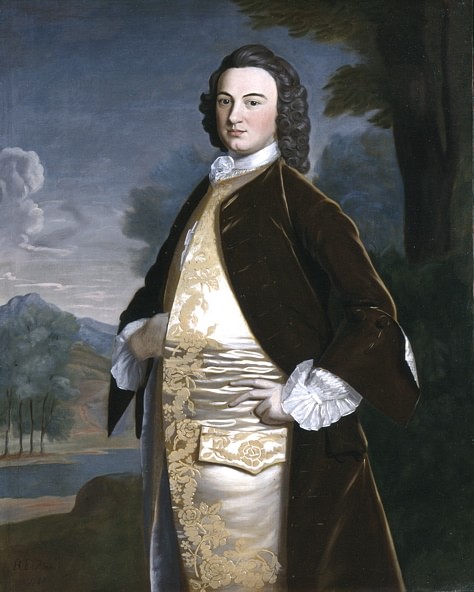
On 29 August 1786, the insurrection known as Shays' Rebellion began when 1,500 people surrounded the Court of Common Pleas in Northampton, Massachusetts, thereby halting court proceedings. Referring to themselves as 'Regulators', after the similar Regulator Movement that erupted in North Carolina two decades earlier, the protestors demanded a stop to the oppressive judicial processes that were depriving them of their properties and liberties. On 5 September, 300 Regulators surrounded the debtors' court in Worcester, Massachusetts. Governor Bowdoin called on the Worcester County militia to disperse them, but the militiamen, many of whom were yeoman farmers themselves, refused to turn out. In the ensuing weeks, crowds of Regulators successfully shut down court proceedings in the Massachusetts towns of Great Barrington, Concord, and Taunton.
Government Response
At the end of October 1786, the Regulator protests died down; most courts had adjourned for the season, and the farmers who constituted the Regulator mobs had to return home to harvest their corn. During the lull, New England's merchant elite and government officials frantically tried to come up with a response to the protests; though none of the protestors had yet resorted to violence, the merchants labeled their movement as an insurrection, claiming that the Regulators wished to overthrow the Massachusetts government, implement agrarian laws, and institute a state of anarchy. This was a wild misunderstanding of the protestors' true grievances, but the Massachusetts elite were unwilling to compromise in the face of discontent. "Every man ought to show his true colors and take a side," announced Governor Bowdoin. "No neutral characters should be allowed" (Szatmary, 70).
One of the most outspoken opponents of the protests was Samuel Adams. Though he had been at the forefront of the Patriot uprising during the American Revolution, Adams now claimed that anyone who rebelled against a legitimate republic should be sentenced to death. In late 1786, he helped author the Riot Act, which suspended habeas corpus for Regulators who had been arrested, allowing them to be jailed indefinitely, and allowed for county sheriffs to use lethal force against the mobs. At the same time, Governor Bowdoin looked to find ways to crush the uprising with military force. He first appealed to the federal government, only to find that Congress would be unable to supply soldiers; under the Articles of Confederation, the federal government had no standing army, and Congress lacked the funds and ability to recruit new troops. Instead, Bowdoin and 125 merchants pooled their funds to hire a private army of 3,000 soldiers. Placed under the command of Benjamin Lincoln, a former general of the Continental Army, this private army mainly consisted of young men from the coastal towns and urban centers, which relied on the affluence of the merchants.
Rebellion
On 28 November 1786, the New England elite was ready to retaliate. A group of 300 riders, led by sons of prominent merchants, rode into Groton, Massachusetts to arrest several Regulator ringleaders. One ringleader, Job Shattuck, was wounded with a saber when he resisted arrest and was hauled off to a Boston prison. Then, on 4 January 1787, General Lincoln's private army marched to Worcester, to guard the courthouse as it reopened for the season. These actions only fanned the flames; as news of the government response spread from town to town, the farmers became further radicalized. "I am determined," one man proclaimed, "to fight and spill my blood and leave my bones at the courthouse 'til Resurrection" (Szatmary, 92). The Regulator movement was no longer about reform; now, the rebels would accept nothing less than the overthrow of the Massachusetts government.
In early January 1787, the rebels divided western and central Massachusetts into four regimental zones, each with a governing committee. The plan was to capture the Springfield Armory, a federal arsenal where 7,000 muskets and bayonets, as well as 1,300 barrels of powder were kept; after arming themselves, the rebels then planned to march on Boston, where they hoped to "destroy the nest of devils who by their influence make the courts enact what they please" (Szatmary, 100). The assault was organized by several leaders, among them Luke Day and Daniel Shays, the latter of whom would become the namesake of the rebellion; both Day and Shays, as well as many of the other rebels, were veterans of the Continental Army and had combat experience.
On 23 January 1787, upwards of 4,000 rebels converged on the Springfield Armory from three directions and laid siege; the armory was defended by militia General William Shepard and 1,300 militiamen. The rebels had initially planned to assault the armory on 25 January, but, at the last moment, Day sent a message to Shays asking to postpone the assault for one day. Day's letter was intercepted by Shepard's forces, however, and Shays never got the message. On 25 January, Shays launched the assault with two-thirds of the rebel force but was unsupported by Day's men. They were greeted by Shepard's militia; after firing warning shots over the heads of the Shaysites, Shepard then ordered two cannons to fire grapeshot into the oncoming crowd. The roar of the cannons quickly dispersed the rebels, leaving four dead and 20 wounded.
After the failure of the assault on Springfield Armory, the rebels fled north, eventually establishing a camp at Petersham, Massachusetts. General Lincoln, upon learning about the assault, immediately marched his army west from Worcester; early in the morning of 4 February, Lincoln's army surprised the Shaysite camp during a snowstorm, sending the rebels fleeing into the countryside, with much of the leadership, including Shays himself, seeking asylum in Vermont or New York State. Satisfied, Lincoln disbanded his army at the end of February, unaware that one final episode of the rebellion was yet to play out. 120 rebels had regrouped in New York and, on 27 February, crossed the border to assault the market town of Stockbridge, Massachusetts. They attacked the homes of several well-known retailers, taking 20 hostages before moving on toward New Barrington.
News of the attack on Stockbridge quickly spread, causing militia General John Ashley to hastily put together a force of 80 men to go after the rebels. Ashley's force caught up with the Shaysites on the evening of 27 February outside the town of Sheffield; the resultant six-minute skirmish was the bloodiest moment of Shays' Rebellion, leaving 30 rebels dead or wounded, and 3 government soldiers dead and several more wounded. Ashley's men won the skirmish, however, and took the surviving rebels prisoner; with the fight at Sheffield, Shays' Rebellion came to an end.
Aftermath & Effect on the Constitution
Governor Bowdoin received the lion's share of the blame for the rebellion; in 1787, he lost re-election to John Hancock, who had prudently avoided any association with the uprising. Hoping to put the matter behind them, Hancock offered a general amnesty to all rebels, provided they admit their complicity in the rebellion. Even Shays himself was pardoned in 1788, although he was still vilified as an anarchist in the Boston press, forcing him to move to New York. Two rebels, John Bly and Charles Rose, were hanged on 6 December 1787, but this was only because they had engaged in looting during the rebellion.
Shays' Rebellion had a major effect on the infant United States. Thomas Jefferson, writing from his post as ambassador to France, was unconcerned when news reached him, believing that such upheavals were healthy for the maintenance of liberty: "I hold it that a little rebellion now and then is a good thing, and as necessary in the political world as storms in the physical" (Meacham, 208). Most of Jefferson's colleagues, however, did not share his optimism. Several political leaders were disturbed by the federal government's inability to respond to the rebellion; support for the Federalists, who had been arguing in favor of a more powerful central government, was therefore strengthened in the aftermath of Shays' Rebellion.
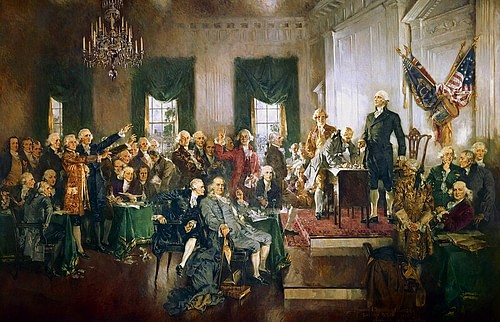
Federalist leaders like Alexander Hamilton and James Madison used the rebellion as an example of how the Articles of Confederation, which prevented Congress from levying its own taxes or maintaining its own army, left the United States weak and vulnerable to future insurrections. Another Federalist, John Jay, wrote in 1787 that Shays' Rebellion made "the inefficiency of the Federal government more and more manifest" (Szatmary, 123). With support for Federalism growing, the Constitutional Convention met in Philadelphia from May to September 1787, ultimately producing the US Constitution. Scholars still debate the precise effect that Shays' Rebellion had on the drafting of the Constitution, although it is suspected that fear of another such rebellion swayed several non-committed delegates into the Federalist camp. Therefore, the primary legacy of Shays' Rebellion is that it helped lead to the drafting of the US Constitution and the creation of a stronger federal government.

